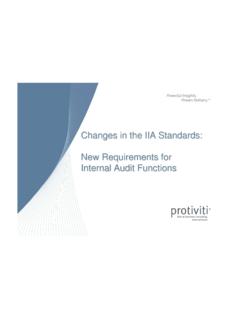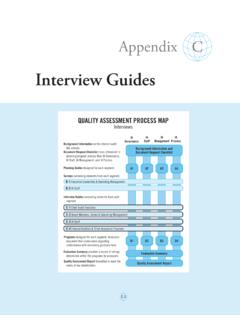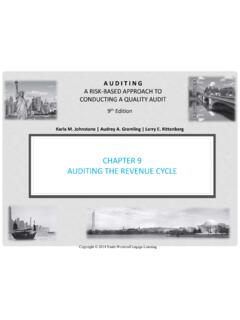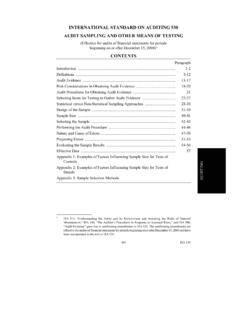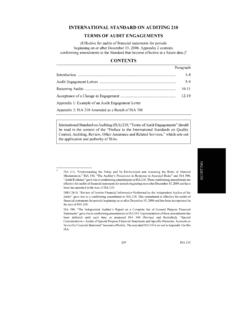Transcription of Auditing IT Governance - IIA
1 Auditing IT Governance About Supplemental Guidance Supplemental Guidance is part of The IIA's international Professional Practices Framework (IPPF ). and provides additional recommended, nonmandatory guidance for conducting internal audit activities. While supporting the international Standards for the Professional Practice of Internal Auditing , Supplemental Guidance is intended to address topical areas, as well as sector-specific issues, in greater procedural detail than the Standards or Implementation Guides. Supplemental Guidance is endorsed by The IIA through formal review and approval processes. Practice Guides Practice Guides are a type of Supplemental Guidance that provide detailed step-by-step approaches, featuring processes, procedures, tools, and programs, as well as examples of deliverables. Practice Guides are intended to support internal auditors. Practice guides are also available to support: Financial Services.
2 Public Sector. Information Technology (GTAG ). For an overview of authoritative guidance materials provided by The IIA, please visit Auditing IT Governance 2. Table of Contents Executive Summary .. 4. Introduction .. 5. IT Governance Overview .. 6. Business Significance .. 8. Key Risks .. 10. IT Governance Components .. 10. The Role of Internal Audit in IT 12. Proficiency .. 13. Engagement Planning ..15. 1. Understand the context and purpose of the engagement.. 15. 2. Gather 17. Obtain and Document 17. Interviewing Relevant 18. 3. Conduct a preliminary risk assessment.. 19. 4. Form engagement objectives.. 20. Consulting Engagement Objectives .. 21. 5. Establish engagement scope.. 22. 6. Allocate resources.. 23. 7. Document the plan.. 23. Reporting the Engagement Appendix A. Related IIA Standards and Guidance ..25. Appendix B. Glossary ..26. Appendix C. IT Governance Internal Controls Questionnaire ..28. Appendix D. Risk and Controls Matrix for IT Governance .
3 31. Appendix E. Additional Acknowledgements ..40. Auditing IT Governance 3. Executive Summary Taking a strategic approach to implementing information technology (IT) Governance helps Alignment of organizational organizations address the speed of technological objectives and IT is more about advancements, IT services proliferation, and the Governance and less about greater dependency on IT to meet organizational technology. Governance assures objectives. Effective IT Governance contributes to alternatives are evaluated, control efficiency and effectiveness, and allows the execution is appropriately directed, organization's investment in IT to realize both and risk and performance are financial and nonfinancial benefits. Often when monitored. controls are poorly designed or deficient, a root cause is weak or ineffective IT Governance . IT Governance is directly related to organizational oversight of IT assets and risks, making it a shared responsibility of senior management1 and the board.
4 Senior management carries out the day-to- day direction that tactically aligns with the overall strategic guidance of the board to ensure the effective, efficient, and acceptable use of IT resources. The primary outcomes of effective IT. Governance include: IT strategies are aligned with organizational objectives. Risks are identified and managed properly. IT investments are optimized to deliver value to the organization. IT performance is defined, measured, and reported using meaningful metrics. IT resources are managed effectively. Absent or poor IT Governance can have significant negative impacts on an organization, both financially and reputationally. Recovery from such impacts requires time, energy, and money. In many organizations, there is a disconnect between senior management and IT due to the old belief that IT exists solely to deliver day-to-day IT services. In reality IT is critical in the development of competitive advantage and to support the achievement of the organization's goals and strategic objectives.
5 The internal audit activity is uniquely positioned and staffed within an organization to assess whether the information technology Governance of the organization supports the organization's strategies and objectives and to make recommendations as needed (Implementation Standard ). As the second edition of Auditing IT Governance , this GTAG has been updated to reflect the 2017. international Professional Practices Framework and to be more directly practical to internal auditors. 1 Senior management usually includes the chief executive officer (CEO), chief financial officer (CFO), chief operations officer (COO), chief marketing officer (CMO). Auditing IT Governance 4. Introduction The highest level of Governance is organizational Governance , which is defined by the international Standards for the Professional Practice of Internal Auditing as the combination of processes and structures implemented by the board to inform, direct, manage, and monitor the activities of the organization toward the achievement of its objectives.
6 IT Governance is a subdiscipline of organizational Governance consisting of the leadership, organizational structures, policies, and processes that ensure that the enterprise's information technology supports the organization's strategies and objectives. IT Governance supports the organization's regulatory, legal, environmental, and operational requirements to enable the achievement of strategic plans and aspirations. Other subdisciplines include corporate Governance responsible for conformance processes and business Governance responsible for performance processes. Figure 1 shows the relationship between organizational Governance and IT Governance . Figure 1: Organizational Governance and IT Governance Relationship Organizational Governance Corporate Business IT Governance Governance Governance Key Organizational Assets Human Physical Financial IT Assets Assets Assets Assets IT Governance Areas Structures Mechanisms Adapted from: Institute de la Gouvernance des Systems d'Information, The place of IT Governance in the Enterprise Governance , 2005.
7 Auditing IT Governance 5. The objective of this guidance is to assist internal auditors in providing assurance services over IT. Governance . The guide provides a high-level description of IT Governance processes, practices, and terminology to help internal auditors attain an understanding of the concept of Governance and its characteristics of good Governance processes. This edition provides tools and techniques to help internal auditors build a work program and perform engagements involving IT Governance . IT Governance Overview Implementing IT Governance is an imperative part of organizational strategies because it is fundamentally concerned with goals that ensure that IT delivers value to the business in a controlled and effective manner. A typical IT Governance framework would focus on five key areas: Strategic alignment IT Governance provides strategic direction of IT and the alignment of IT and the business with respect to services and projects, business objectives, up-to- date IT strategy, linkage between business objectives, and IT initiatives.
8 Risk management IT Governance can help determine what processes are in place to ensure that risks have been adequately addressed. Additionally, it can ensure that enterprise risk management includes risk aspects of IT investments, defined responsibilities for risk management, defines a common risk analysis methodology, and define strategies for addressing risks, continuous monitoring of threats, occurrence, and impact in a holistic manner. Value delivery IT Governance helps IT and the business to create a partnership designed to drive maximum business value from IT. The business is enabled to oversee the delivery of value by IT, and measure return on investments (ROI), IT tactical plan execution, and clear benefits for each level of the organization. For example, system uptime (infrastructure strategy), degree of automation in the software development (SDLC). strategy, productivity (operational strategy), and ultimately revenue (IT financial strategy).
9 Performance measurement IT Governance provides the mechanisms to verify strategic compliance ( , achievement of strategic IT objectives), measure IT performance, and its contribution to the bottom line ( , delivery of promised business functionality). Further metrics include continuous monitoring and reporting, follow-up policies, root cause analysis and problem management, benchmarking against industry practices, and proven standards or frameworks. Resource management IT Governance provides high-level direction for sourcing and use of IT resources to: oversee the aggregate funding of IT at the enterprise level; and ensure there is an adequate IT capability and infrastructure to support current and expected future business requirements, sourcing strategies, human management practices, user manuals, segregation of duties, time reporting, infrastructure life cycle management, service level agreements (SLAs), and acceptable usage policies.
10 Auditing IT Governance 6. Some of the challenges that IT Governance can help organizations address include: The increasing complexity of IT environments. A growing dependency on data to make business decisions. The proliferation of mobile devices. The need to exchange information with customers, service providers, and business partners. The increasing risk of cyberattacks. An increase in laws and regulations related to data protection. In the IT Governance conceptual framework, senior management and the board are responsible for establishing the organization's IT objectives in alignment with the overall business strategy;. defining IT strategies to achieve business objectives; and establishing IT Governance policies, organizational structures, and processes to manage the risks to accomplishing those objectives. IT management is responsible for the day-to-day activities of an organization: planning, executing, and monitoring the use of IT resources to ensure the achievement of the strategies and policies established by the board.



